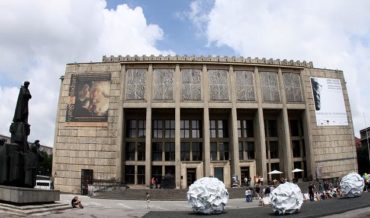Contents
Key Facts
- Born in 1886 in Kraków into the renowned Kossak artistic dynasty
- Son of celebrated painter Wojciech Kossak, inheriting exceptional artistic talent
- Attended the Cadet School, which profoundly influenced his military-themed artwork
- Specialized in battle scenes, historical paintings, and hunting scenes with masterful equestrian subjects
- Famous for collaborative works with his father, creating unique joint signatures on shared paintings
- His works are permanently displayed at the National Museum in Krakow
- Died in 1955 in Krakow, completing his artistic journey in his birthplace
Early Life and Education
Jerzy Kossak was born in 1886 in Kraków into one of Poland's most distinguished artistic families, representing the third generation of the legendary Kossak artistic dynasty. As the son of Wojciech Kossak, one of Poland's most celebrated battle painters, Jerzy was immersed in artistic techniques and Polish military traditions from childhood. The Kossak family legacy began with his grandfather, Juliusz Kossak, who established the family's reputation as masters of historical and military painting in the 19th century.
His attendance at the Cadet School proved instrumental in shaping his artistic vision and technical expertise. This military education provided him with firsthand knowledge of cavalry formations, military equipment, uniform details, and the disciplined spirit of Polish military traditions. Unlike artists who painted military subjects from external observation, Kossak's cadet training gave him an insider's understanding of military life, lending authenticity and emotional depth to his later battle scenes.
Artistic Style and Technical Mastery
Signature Subjects and Themes
Jerzy Kossak primarily specialized in battle scenes, historical paintings, and hunting compositions, establishing himself as a leading interpreter of Polish military heritage. His canvases consistently featured:
- Horses in dynamic motion – rendered with exceptional anatomical precision, capturing both the physical power and emotional intensity of cavalry charges
- Polish lancers and cavalry soldiers – depicted in moments of heroic action, often showing the famous Polish winged hussars and napoleonic-era formations
- Aristocratic hunting scenes – portraying the cultural traditions of Polish nobility
- Historical battle recreations – focusing on pivotal moments in Polish military history with careful attention to historical accuracy
Advanced Painting Technique
Kossak's technique represented a sophisticated blend of academic realism and dynamic impressionistic elements, rooted in the tradition established by institutions like the Academy of Fine Arts. His brushwork demonstrated remarkable versatility – employing swift, energetic strokes to convey movement and action, while maintaining meticulous attention to anatomical detail and historical accuracy. His color palette typically featured rich earth tones contrasted with vibrant reds and blues, creating dramatic visual impact while remaining true to historical military uniforms and equipment.
His mastery of equestrian subjects set him apart from contemporary artists. Kossak could capture horses in various states of motion – from the tense anticipation before battle to the explosive energy of cavalry charges. This expertise stemmed from both his military training and the Kossak family's generations-long specialization in equestrian art.
Unprecedented Father-Son Artistic Collaboration
One of the most extraordinary aspects of Jerzy Kossak's career was his extensive collaboration with his father, Wojciech Kossak. These joint works, bearing both artists' signatures, represent a rare phenomenon in art history where two master painters from different generations combined their talents seamlessly.
The collaborative process typically involved complementary contributions: Wojciech would often establish the historical framework and overall composition, drawing from his extensive knowledge of Polish military history, while Jerzy contributed fresh technical approaches and contemporary artistic sensibilities. These dual-signature paintings are particularly prized by collectors and museums for their unique artistic dialogue between generations and their exceptional technical quality.
The collaboration extended beyond mere technical cooperation – it represented a living transmission of Polish cultural memory and artistic tradition from one generation to the next, ensuring the preservation of Poland's visual military heritage during a period of significant political upheaval.
Professional Recognition and Prestigious Commissions
Jerzy Kossak received numerous commissions from Polish military institutions, establishing himself as the premier painter of contemporary Polish military subjects. His reputation for historical accuracy and artistic excellence made him the preferred choice for:
- Officer regimental clubs seeking portraits of unit traditions and battle honors
- Military academies requiring ceremonial paintings and historical documentation, including institutions that would later be commemorated in places like the Polish Aviation Museum
- Government institutions commissioning official portraits and state ceremonial works
- Private aristocratic families preserving their military heritage through portraiture
- Cultural organizations dedicated to maintaining Polish historical memory
These commissions were not merely decorative but served as important historical documents, preserving details of military uniforms, equipment, and traditions that might otherwise have been lost during Poland's turbulent 20th century history.
Masterworks and Museum Legacy
National Museum Collection
The National Museum in Krakow houses two of Jerzy Kossak's most significant works: "Bitwa pod Piramidami" (Battle of the Pyramids) and "Portret Jordanowej" (Portrait of Jordanowa). These paintings demonstrate the full range of his artistic capabilities:
"Bitwa pod Piramidami" represents Kossak's mastery of large-scale historical composition, depicting Polish forces in Napoleon's Egyptian campaign. The painting showcases his ability to create dramatic battle scenes with multiple figures while maintaining individual character and historical accuracy in uniforms and equipment.
"Portret Jordanowej" illustrates his sophisticated approach to portraiture, combining technical precision with psychological insight, characteristic of the Polish aristocratic portrait tradition.
Artistic Innovation Within Tradition
While deeply rooted in the academic tradition inherited from his father and grandfather, Jerzy Kossak subtly incorporated elements reflecting early 20th-century artistic developments. His work shares thematic connections with the broader Polish artistic heritage preserved in venues like the Cloth Hall Gallery of 19th-century Polish art and continues the tradition of masters commemorated at the Jan Matejko House. His handling of light and atmospheric effects showed evolution beyond strict realism toward a more dynamic, almost cinematic approach to historical subjects, while maintaining the emotional resonance essential to Polish national identity.
Historical Context and Cultural Significance
Jerzy Kossak's career spanned one of the most tumultuous periods in Polish history, from the final decades of partitioned Poland through independence, World War I, the interwar period, World War II, and the early communist era. His paintings serve as visual chronicles of Polish military traditions during this transformative period, preserving cultural memory when Poland's very existence as a nation was repeatedly threatened. His works complement the historical preservation efforts of institutions like the Historical Museum of Krakow and contribute to the same mission of maintaining Polish heritage found at the Home Army Museum.
The royal and military heritage of Poland that Jerzy painted, particularly scenes connected to Wawel Castle and Polish aristocratic traditions, found new expression through his brush during a time when such traditions were under constant threat. His artistic legacy is preserved alongside other masters of Polish art at institutions like the Czartoryski Museum and the Józef Mehoffer House.
His death in 1955 marked the end of an era for Polish military painting and the conclusion of the Kossak family's three-generation artistic dynasty. The timing of his death, just a decade after World War II's conclusion, meant he witnessed and potentially documented some of the most dramatic events in Polish history.
Enduring Legacy and Contemporary Relevance
Today, Jerzy Kossak is recognized as a crucial bridge between 19th-century Polish romantic nationalism and 20th-century historical realism. His works transcend mere artistic achievement, functioning as important historical documents that preserve the visual memory of Polish military traditions, aristocratic culture, and national identity during periods of political upheaval. His paintings serve as artistic monuments to Polish military valor and cultural continuity.
Art historians particularly value his contributions to the continuity of Polish cultural tradition, noting how his collaborations with Wojciech Kossak created an unbroken chain of artistic knowledge and cultural memory spanning nearly a century of Polish history. His influence extends to contemporary Polish military artists and historians who continue to reference his works for historical accuracy and artistic inspiration.
The Kossak family legacy, culminating in Jerzy's mature works, represents one of Poland's most significant contributions to European military and historical painting, establishing a distinctly Polish school of artistic interpretation that influenced generations of subsequent artists.

